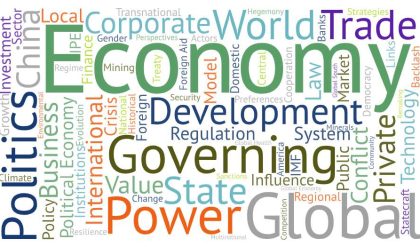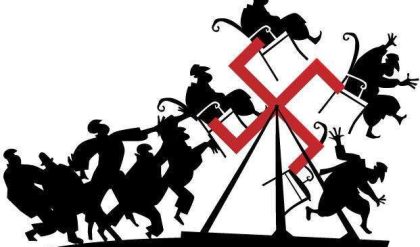The edited collection by Sathyamurthy 3 analyses the agricultural, industrial and technological policies of the Indian state. The overall outcome of these policies has been a development process which is skewed in favour of certain regions and classes at the expense of other regions and classes. In the process, contradictions of a vertical nature (for example, between dominant and dominated classes, upper-middle castes and lower castes) have come to coexist with horizontal (for example, intra-ruling class) contradictions. In sum, the Indian political process has been characterised by two signiŽ cant trends. These are a growing regionalisation of the polity and the emergence of new social groups as signiŽ cant actors on the political scene. One of these actors is the ‘class’ of farmers. Their political action and their relation to the state are the thrust of Varshney’s work.4 He argues that a democratic system introduced before an industrial revolution has led to a rise in farmers’ political power. All political parties, including the left parties, support their demands for higher farm prices and subsidies. Farmers have therefore succeeded in preventing the worst-case scenario from taking place, this being the fall in producer prices that normally accompanies an accumulating grain surplus. But the best-case scenario, that is, continual increases in farm returns irrespective of the rhythms of technical change, remains unrealised. That is because rural power is subject to serious constraints.
On the one hand, the farmers’ organis- ation, which aimed at putting pressure on the state for more resources, is impeded by crosscutting cleavages within the farming community (for example, caste, ethnicity and religion). On the other hand, millions of poor Indians cannot afford costly food. Besides, there is also a limit to the extent to which the state can subsidise the rural sector, which is very large compared to that in more developed countries. State subsidy is especially a problem because farmers are only one group among many competing for the state’s resources. Dre`ze and Sen point to a different type of state failure in India, namely, its failure to remove poverty, illiteracy, disease and inequality of opportunity.5 Nevertheless, they argue that the state, or more generally public action, can contribute to a people-centred economic development aimed at the expansion of human capabilities. They suggest that economic development requires the mutually supportive interaction of public action, including state policies, and market stimulation. The pro-market (or neoliberal) reform policy of the Indian state is the theme of Kurien’s book.6 Since the introduction of these reforms in 1991, the Indian economy has been increasingly connected to global capitalism. Kurien discusses the nature and the implication of that connection. Reforms have been sponsored by a tiny minority to promote its speciŽ c interests, although neoliberalism has been promoted politically as being in the national interest. India’s balance of payment situation has improved, but its debt situation has worsened. Industrial exports have not signiŽ cantly increased.
This is partly because of quota restrictions imposed by western countries, and because exports have remained concentrated in traditional areas such as textiles. Finally, the way that neoliberal reforms have impacted on the poor is the theme of the Rao and Linnemann collection.7 It draws our attention to the signiŽ cant rise in absolute poverty in villages in the immediate post-reform period, reversing the earlier trend of a decline in poverty. The claim is that the reduction in public investment and social expenditures as part of neoliberal policy has contributed to poverty. In the remainder of the essay, I will critically consider a few selected issues. These are: the class character of Indian society; the nature and actions of the state and its ‘democratic’ form; and concepts and explanations of poverty and development. I have chosen these issues because they are all important political- economic issues and because they are common themes in more than one book under review.
In the other works under review, there is a good discussion of India’s class map in several chapters of the Sathyamurthy collection and also in Kurien. During the last four decades, says Sathyamurthy, the Indian capitalist class has vastly expanded. In addition to the national industrial large bourgeoisie , the capitalist class also includes the agricultural bourgeoisie, the provincial industrial bourgeoisie and the non-resident Indians. The non-capitalist class includes the poor peasantry, the landless, agricultural workers, the urban petty bourgeoisie and the industrial working class, including its semi-skilled and unskilled seg- ments and the casual and contractual labourers.16 However, the regionally important feudal, semi-feudal and the feudally exploited people (for example, bonded labourers) are not discussed. Given that feudal elements tend to impede the exercise of bourgeois state power, this is an important omission. Several writers stress the signiŽ cance of the political actions of classes. Thus classes are seen as both classes in and for themselves. This is to the good.
The political action of farmers, in particular, has received considerable attention. But there is also some discussion of the urban working class to which I will turnrst. Indian labour, according to Basu in the Rao and Linnemann collection, is one of the most expensive in the world. This is not because wages are high but because of high indirect costs of labour (for example, strikes). Clearly, Basu wants a quiescent labour, waiting to receive adequate wages by virtue of the sweet will of employers.17 This is, of course, somewhat different from Dre`ze and Sen’s general acceptance of the role of public action, which, signiŽ cantly, includes working class organisation, in economic development, although they do say that too much adversarial public action can hurt economic growth, as in Kerala. Turning now to farmers’ political action, for Varshney the claim that the new farmer agitations are class-driven is weak. Rather than having a narrow class base in the surplus-producin g rich peasantry, the new farmers’ movement has the support of all sections of the landed peasantry. For example, there is widespread support by small farmers for higher prices for cash crops as well as for food crops and lower input prices. Marginal farmers (that is, the food deŽ cit farmers) can also be expected to support higher prices for cash crops and lower input prices, but they do not unless strong political reasons (for example, organisation as a check on the bureaucratic abuse of input delivery) and visible employment effects are simultaneously present. Labourers tend not to support these agitations, but, where they do, it could be mainly due to their dependence upon the rich farmers for wages and loans






Comments are closed.